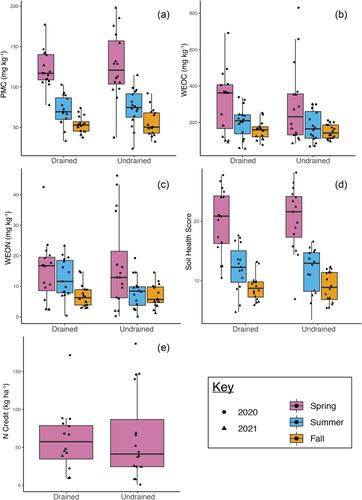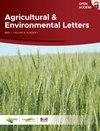Haney Soil Health Test changes with season, not subsurface drainage
IF 3.6
4区 农林科学
Q1 AGRICULTURE, MULTIDISCIPLINARY
引用次数: 1
Abstract
The Haney Soil Health Test (HSHT) is used to quantify soil health using soil biological activity and water‐extractable C and N. However, suitability of the HSHT to measure soil health in subsurface drained fields remains unknown. Our goals were to use the HSHT in Minnesota cropand to (a) test the effect of recent tile drainage installation, (b) evaluate seasonal variability, and (c) calculate a potential N fertilizer credit. Three soil biological indices used in the HSHT were measured seasonally across 2 yr and used to calculate a soil health score and N credit. All metrics were unaffected by subsurface drainage, but all varied seasonally (greatest in spring) and annually (greater in 2020 than in 2021). Soil biological indicators did not change abruptly following subsurface drainage but may change gradually, and this needs to be tested further. Significant seasonal variability may pose challenges in tracking soil health over time.

哈尼土壤健康测试随季节而变化,而非地下排水
哈尼土壤健康试验(HSHT)是利用土壤生物活性和水可提取的C和n来量化土壤健康的方法。然而,HSHT在地下排水田测量土壤健康的适用性尚不清楚。我们的目标是在明尼苏达州的农田中使用HSHT来(a)测试最近安装的瓦片排水装置的效果,(b)评估季节变化,(c)计算潜在的氮肥信用。HSHT中使用的三个土壤生物指标在2年内进行季节性测量,并用于计算土壤健康评分和N信用。所有指标都不受地下排水的影响,但所有指标都有季节性变化(春季最大)和年度变化(2020年大于2021年)。土壤生物指标在地下排水后不会突然变化,但可能会逐渐变化,这需要进一步测试。显著的季节变化可能给长期跟踪土壤健康状况带来挑战。
本文章由计算机程序翻译,如有差异,请以英文原文为准。
求助全文
约1分钟内获得全文
求助全文

 求助内容:
求助内容: 应助结果提醒方式:
应助结果提醒方式:


